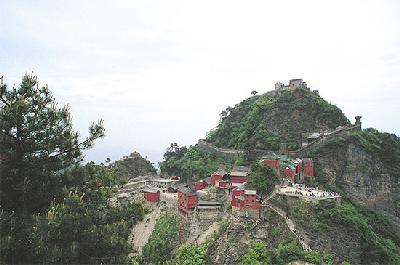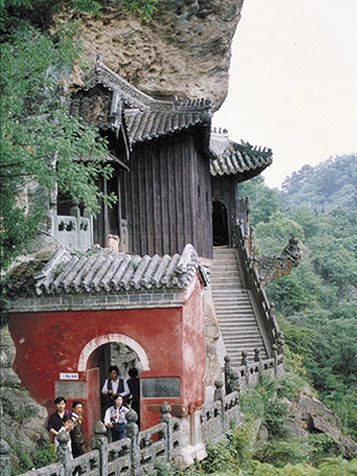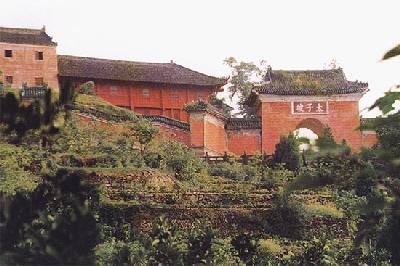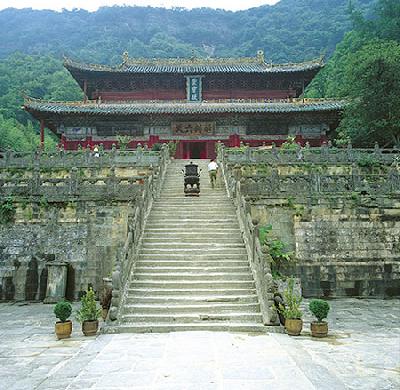|

Wudang Mountain, also called Taihe Mountain or Xianshi Mountain in the past, is located near the city of Danjiangkou, in central Hubei Province. There are 72 peaks, 36 cliffs, 24 gullies, 3 lakes, 9 springs and 10 ponds there. The main peak, Tianzhu Peak, has an altitude of 1,612 m.

Wudang Mountain is well vegetated and boasts rich plant resources. About 600 kinds of Chinese herbs, one third of the total recorded in the encyclopedic Compendium of Materia Medica written by Li Shizhen in the Ming Dynasty (1368-1644), grow on the mountain. For this reason, the mountain is also famous as a natural drugstore.

Wudang Mountain is a scenic resort perfectly integrating natural landscape with manmade buildings. Taoist temples are prominent here. During the reign of Emperor Zhenguan of the Tang Dynasty (627-649), the Wulong (five dragons) Temple was built. And in 1412, Emperor Zhu Di, an enthusiastic Taoist, ordered the construction of 33 temples, which were completed in 1423. The various Taoist structures cover a total area of 1.6 million sq. m. Among them, the most magnificent temple is the Golden Hall, which is made of fine copper on a granite foundation. The seated Taoist figure in the hall is cast so exquisitely that it is regarded as a masterpiece representing the highest level of ancient China's copper casting.
There are four Taoist palaces, remains of two other palaces, two temples and a number of cliff temples and halls of worship remaining on Wudang Mountain. The original features of these constructions are well preserved in terms of layout, design, style, materials and technique. Taoist halls are mainly built in secluded nooks or on terraces, surrounded by nunneries and halls of worship. And cliff temples are usually built on prominent peaks, with which the mountain abounds. The temples and halls are architecturally superb, and have great cultural and technological value. They are invaluable material for the study of the politics of the early Ming Dynasty, the religious history of China and ancient Chinese buildings.
The major characteristics of ancient groups of buildings on Wudang Mountain can be summed up as follows:
1. Superb Techniques

The buildings vary in style, and are constructed with different materials. There are wooden temples, copper halls and stone cliff temples. Statues made from copper, wood, stone and earth are noted for their delicate techniques and artistic creativity.
2. Treasure House of Taoist Architecture
The Taoist buildings on the mountain were planned by emperors, and managed by imperial officials. The buildings were designed on such a grand scale, constructed with so much care, and furnished with so many lavish statues and items of worship that they are regarded as unprecedented masterpieces among China's existing Taoist constructions.
3. Historical Significance
The extensive construction on Wudang Mountain was carried out when Emperor Zhu of the Ming Dynasty was making great efforts to expand external contacts and promote Taoism in the country. He intended to consolidate his rule by instilling into his subordinates the idea that the imperial power is endowed by Heaven. Therefore, these Taoist buildings are of great significance for the study of the history and religious belief of that period.
The history of Taoism at Wudang Mountain can be traced back about 2,000 years. It began to prosper in the Tang and Song dynasties, and reached its heyday in the Ming Dynasty. Taoism witnessed a decline in the ensuing Qing Dynasty (1644-1911), but it was revitalized after the founding of New China in 1949.
Taoist ritual activities follow a set of procedures handed down through generations of Taoist priests. The priests recite ancient scriptures and play Taoist music, following a centuries-old formula. Taoist music has been extensively studied by scholars and experts.
Wudang Mountainwushu, noted for its exercise of the internal organs and breathing techniques, developed along with Wudang Mountain Taoism. Taoist priests put equal emphasis on religious practice and promotion of the health. They derived the principles ofwushufrom Taoist theories and applied Taoist practical approaches towushuskills, thus gradually developing Wudang Mountainwushuwhich integrates ancient Chinese philosophy with extraordinarywushuskills. In the Ming Dynasty, Wudang Mountainwushureached its height through the outstanding efforts of a Taoist priest named Zhang Sanfeng, and gradually became one of the major schools of Chinesewushu.
|